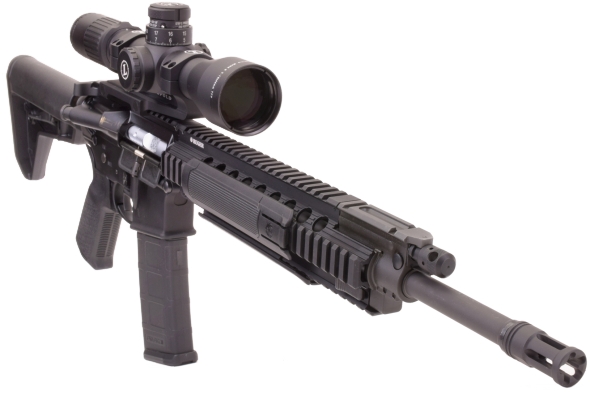
Ruger has cleanly engineered the SR-556TD as a take down version of the SR-556, complete with a quick change barrel system. The SR-556TD has all of the performance features of the standard SR-556, however, this version can be taken down to stow in a small 22″x7″x5″ soft case, with room left over for multiple magazines and popular accessories. Additionally, with the purchase of an accessory barrel, the TD version can be configured as a 5.56 NATO or 300 Blackout in under twenty seconds. Pictured above with Leupold Mark 6 3-18x44mm scope.
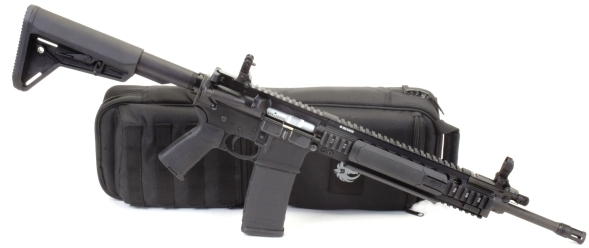
The take down, quick change barrel system
To remove a barrel – Bolt back and locked open, remove mag, check for clear. Pull the small slider bar back (see photo below), twist the barrel 1/8 turn counterclockwise and pull the barrel. The transfer rod remains with the handguard and upper receiver. To reinstall a barrel – index and insert the barrel as removed, rotate 1/8 turn clockwise until the audible click of the Slide Bar engagement is heard. When swapping between different barrel types, headspace is preset at the factory and accessory barrels are complete, so there are no adjustments to make or parts to transfer when switching barrels.

Further take down is accomplished like other rifles of this type; push the take down and pivot pins out to the detent positions and the upper and lower receiver separate.

On the receiver end of the barrel, the extension has a spline with 8 0.200″x0.225″ teeth. In place of a conventional barrel nut, the SR-556TD has a cylindrical barrel nut that extends approximately 2″ forward of the upper receiver face; smooth on the outside and splined on the inside. Approximately 1″ in, the spline is interrupted with a circumferential groove that allows the barrel to be inserted, then twisted to bring the barrel extension and barrel nut splines into locked alignment. Seen below, the barrel nut upper image, engaged with barrel, lower image…

The barrel nut locates the barrel fore and aft, the front latching system prevents it from unintentional rotation. At the far end of the handguard, as the barrel is pushed inward to align the splines, a lug on the underside of the gas block depresses the spring loaded barrel latch. Twisting the barrel approximately 1/8″ turn clockwise turns the gas block lug into contact with the lower hand guard. In this position, the barrel latch engages the center notch in the gas block, which locks the barrel and prevents it from rotating. A very long description of a very quick and simple operation.
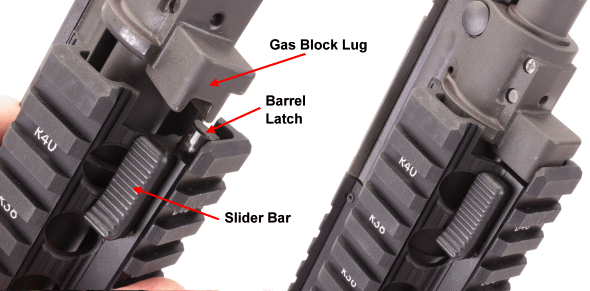
This SR-556 saw a good deal of ammo; various types of 5.56 NATO, 223 Remington and 300 Blackout, both sub and supersonic. A sighted in barrel could be removed and reinstalled without losing zero. Point of impact did shift from one barrel/cartridge type to the next, as would be expected with changes in velocity and bullet mass, but the shift was consistent. Keeping track of sight adjustments when changing from one barrel to the other, I was able to make the appropriate adjustment to the sights after a barrel change without having to fire a live round. Additionally, after many cycles of firing and barrel swaps, both the lugs on the barrels and the interior spline in the barrel nut showed no signs of wear.
Weeks earlier…
Getting my hands on an interesting new firearm, and then attempting to write a full and logical presentation, is tough. I tend to push the items of greatest interest to the top of the story and then define the firearm in overview. In this case, the nifty take down/barrel changing features that immediately got my attention are actually affixed to a complete rifle with other positive attributes, all which deserve mentioned.
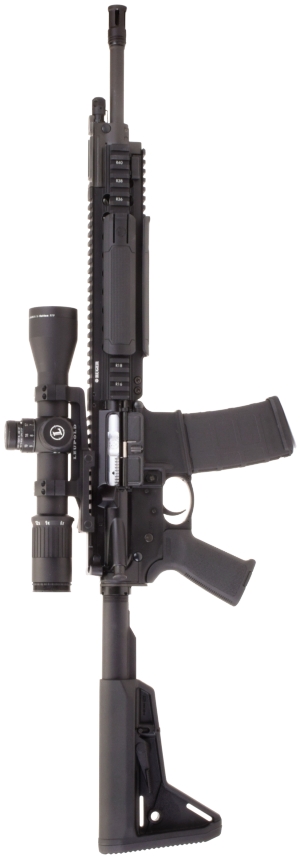
|
Ruger SR-556TD |
|
| Manufacturer | Ruger – Mayodan, NC |
| Item # | 5901 |
| Type | Gas Operated – Piston |
| Caliber | 5.56 NATO/223 Rem* |
| Mag Capacity | 30 Rounds |
| Barrel Length | 16.1″ |
| Rifling Twist | 1:9″ |
| Weight | 7 Lbs. 10 Oz. |
| Overall Length | 32.8 – 36.1 |
| Stock | MOE SL Collapsible |
| Hardware Finish | Manganese Phosphate/Anodized |
| Length of Pull | 11.1″ – 14.4″ |
| Sights – Rear | Folding – Windage Adjustable |
| Sights – Front | Folding – W & E Adjustable |
| Scope Mount | Picatinny Rail |
| Safety | Rotating |
| MSRP | $2,049** |
|
**Includes 3 30 round magazines, 3 rail covers, sight adjusting tool and soft case. |
|
Manufactured in America
The SR-556TD is made in Ruger’s newest manufacturing facility in Mayodan, North Carolina. With so many firearm manufacturers being gobbled up and shifting production to foreign locations, Ruger expanded their operations by converting a defunct yarn-dying mill into a 220,000 square feet of state of the art manufacturing facility. Ruger now manufactures in New Hampshire, Arizona and North Carolina. Lots and lots of good American jobs.
Piston Powered
Below, the 4 position gas regulator removed from the gas block; few parts and simple system and easy to maintain.
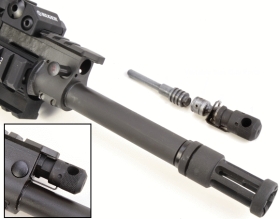
Ruger defines the SR-556 as a gas operated, piston driven, box magazine fed, autoloading rifle. In short form, gas is bled from the barrel into a gas block like other AR types, however, rather than pumping gas and powder residue into the rifle’s receiver, bleed gas drives a piston within the gas block, that drives a transfer rod that cycles the rifle. The result is a cleaner and cooler running firearm and the ability to adjust the gas block, without tools, to accommodate various types of ammunition.
The potential for expanded capability…
The SR-556TD ships as a 5.56 NATO/223 Remington compatible firearm, however, a drop in barrel kit to convert it to 300 Blackout capability is sold through the Ruger Store. Barrels purchased as accessories have an MSRP of $449 and include: gas block, front sight, flash hider, and two applicable magazines. Headspace is preset at the factory.
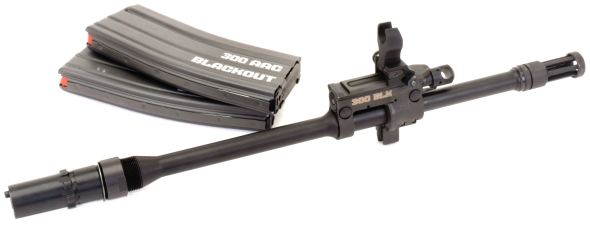
In this case, the rifle is supplied with a well established 22 caliber centerfire, suitable for varmint to medium size game hunting and for security applications The 300 Blackout provides a significant boost to 30 caliber power and the added dimension of subsonic ammunition for suppressed applications. The tables below are based on chronograph data recorded with the SR-556TD and its 6.1″ barrels.

| Sierra 50 Grain BlitzKing 242 Yards Point Blank Range | ||||||
| Range – Yards | 0 | 100 | 200 | 300 | 400 | 500 |
| Velocity – fps | 2630 | 2284 | 1966 | 1677 | 1426 | 1223 |
| Energy – ft.-lbs. | 768 | 579 | 429 | 312 | 226 | 166 |
| Momentum – lbs-sec | 0.58 | 0.51 | 0.43 | 0.37 | 0.32 | 0.27 |
| Path – in. | -1.5 | 2.9 | 0.5 | -10.9 | -34.9 | -76.0 |
|
Berger 168 Grain VLD 197 Yards Point Blank Range |
||||||
|
Range – Yards |
0 |
100 |
200 |
300 |
400 |
500 |
|
Velocity – fps |
1938 |
1796 |
1660 |
1534 |
1419 |
1314 |
|
Energy -ft.-lbs. |
1401 |
1203 |
1028 |
878 |
751 |
644 |
|
Momentum -lbs-sec |
1.44 |
1.33 |
1.23 |
1.14 |
1.05 |
0.98 |
|
Path – in. |
-1.5 |
3.0 |
-3.3 |
-22.3 |
-56.0 |
-107.1 |
The 300 Blackout is not as flat shooting as the 5.56 NATO, but its trajectory out to 300 yards is very manageable and kinetic energy levels are far superior to the 5.56 NATO out to 500 yards. The 30-30 WCF with 170 grain bullet is faster at the muzzle than the 168 grain 300 Blackout represented in the table above, however, at 200 yards the 300 Blackout bullet is pulling away, traveling faster and generating greater kinetic energy and momentum. I think it is appropriate that the rifle is packaged with the 5.56 NATO/223 Remington barrel. The round is versatile, generates next to no recoil and is inexpensive to shoot. The 300 Blackout accessory barrel makes the compact SR-556TD a good choice for hunting deer, black bear and hogs in supersonic form and exceptionally quiet with a suppressor in subsonic form.
Sight / accessory mounting

The SR-556TD is a flattop with a Picatinny rail that extends from receiver to the full length of the quad rail handguard where three more Picatinny rails are present. There is plenty of room to fit virtually all of the metallic, electronic and optical sight systems desired. The rails are positioned marked, three rail covers are included with the rifle.
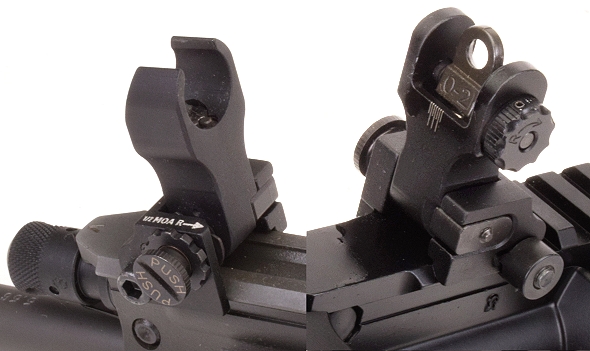
The SR-556’s folding sights are made of 6061 T6 aluminum with stainless steel locking hardware. The rear sight is windage adjustable with 0.625 MOA increments. Both rear sight apertures flip into alignment along a common plane, so either can be used without compensation adjustment. Sampson Manufacturing specs the 0-2 large aperture for use up to 300 meters and the small aperture out to 600 meters. The front sight windage increment of adjustment is 1/2″ MOA, elevation is 1.75″ @ 100 yards per quarter turn of adjustment.

Leupold Mark 6 3-18x44mm scope with CMR-W 7.62 reticle was installed with a Leupold Mark 6 34mm Integral Mount. It was easy to move the scope on and off without losing zero and axis and parallax adjustments stayed put throughout the project. The scope’s placement was ideal for the Ruger’s comb height, forming natural line of sight, optical centerline alignment. Based on clarity, brightness and contrast of image, the Mark 6 is truly an exceptional scope in a very compact package.
Lower than typical AR maintenance requirement
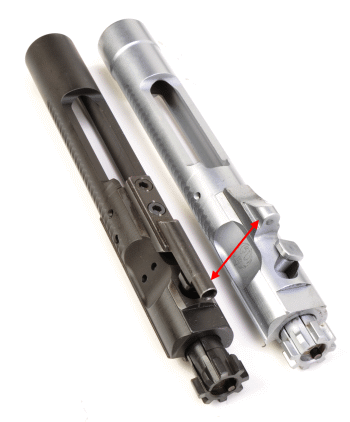 The SR-556 utilizes design, materials and select finishes to reduce required maintenance. Photo, left, illustrates the difference between a gas tube bolt carrier key and the Ruger’s transfer rod actuated bolt carrier. The SR-556 system runs cooler and powder residue is not passed to the bolt carrier. The bolt is chrome plated.
The SR-556 utilizes design, materials and select finishes to reduce required maintenance. Photo, left, illustrates the difference between a gas tube bolt carrier key and the Ruger’s transfer rod actuated bolt carrier. The SR-556 system runs cooler and powder residue is not passed to the bolt carrier. The bolt is chrome plated.
The transfer rod and handguard are not removed for ordinary cleaning and service. The ST-556TD produces little… gunk to accumulate and the transfer rod has a nickel Teflon coating that sheds even the most abrasive environmental grit. As noted previously, the two stage gas driven piston runs clean and the gas block and regulator are easy to disassemble, clean and service.
The barrel is hammer forged, chrome lined and MIL-SPEC 41V45 compliant. All SR-556 steel pieces receive a Manganese Phosphate finish, aluminum pieces are hard coat anodized.
Live fire – 223 Remington
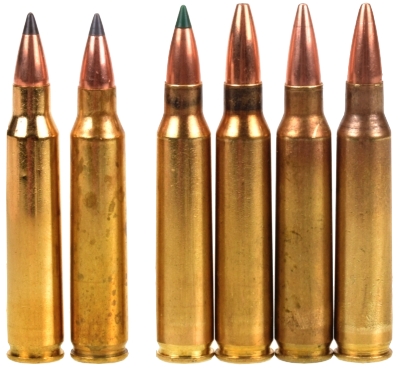
Six types of ammunition were used to gather velocity and accuracy data. As detailed on the table below, two factory loads and four handloads. Throughout the process there were no failures to feed, eject or fire. Shooting was done from a steady rest.
| Warning: Bullet selections are specific, and loads are not valid with substitutions of different bullets of the same weight. Variations in bullet material and length will alter net case capacity, pressure and velocity results. Primer selection is specific and primer types are not interchangeable. These data represents maximum loads in our firearms and test equipment and may easily be excessive in other applications. All loads should be reduced by 5%, and developed following safe handloading practices as represented in established reloading manuals produced by component manufacturers. Presentation of these loads does not constitute a solicitation for their use, nor a recommendation.
|
|||||||||||||||||||||||||||||||||||||||||||||||||||||||||||||||||||||||||||||||||||||||||||||||||||
|
|||||||||||||||||||||||||||||||||||||||||||||||||||||||||||||||||||||||||||||||||||||||||||||||||||
Live fire 300 Blackout
The SR-556TD was changed over to 300 Blackout and five handloads and two factory loads were fired. The Ruger outshot both an Advanced Armament MPW and Ruger’s own Mini-14 300 Blackout in terms of overall accuracy. There were no cycling problems with supersonic ammo. I did shoot a few rounds of subsonic for accuracy checking, but none with a silencer in place.
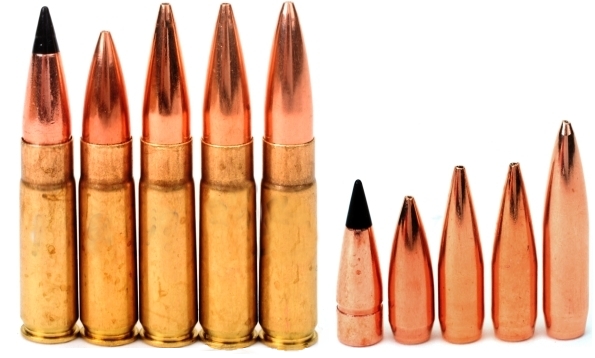
I saw no reason to wring out the rifle with subsonic ammo and no silencer as the combination of highly detuned ammunition with no operational upside makes little sense. Testing a firearm with subsonic ammo and no suppressor is like complaining to your doctor you experience a loss of hearing when you stick your finger in your ear. He would no doubt suggest that you remove your finger as it was never intended to be in there.
Warning: Bullet selections are specific, and loads are not valid with substitutions of different bullets of the same weight. Variations in bullet material and length will alter net case capacity, pressure and velocity results. Primer selection is specific and primer types are not interchangeable. These data represents maximum loads in our firearms and test equipment and may easily be excessive in other applications. All loads should be reduced by 5%, and developed following safe handloading practices as represented in established reloading manuals produced by component manufacturers. Presentation of these loads does not constitute a solicitation for their use, nor a recommendation.
|
||||||||||||||||||||||||||||||||||||||||||||||||||||||||||||||||||||||||||||||||||||||||||||||||||||||||||||||
|
||||||||||||||||||||||||||||||||||||||||||||||||||||||||||||||||||||||||||||||||||||||||||||||||||||||||||||||
I was pretty happy with some of the 300 Blackout handload results, not so much with others. For the sake of expediency, I went with Lil’ Gun across the board based on performance with other 300 Blackout firearms. Both the Hornady 130 grain and 225 grain need a powder type change and greater refinement in picking a spot along the velocity curve… and perhaps a primer type change. There is an active 300 Blackout project in process for this rifle, so we will release further information.
Last words before I stop for the day…
The SR-556TD is a solid product introduction. Too often these days, putting a new camo pattern on a gun stock is cause to break out the party noise makers and toss the confetti. About a year ago I sold off all but one of my personal AR type firearms when I decided I didn’t like having multiple firearms or uppers to have access to more than one caliber.
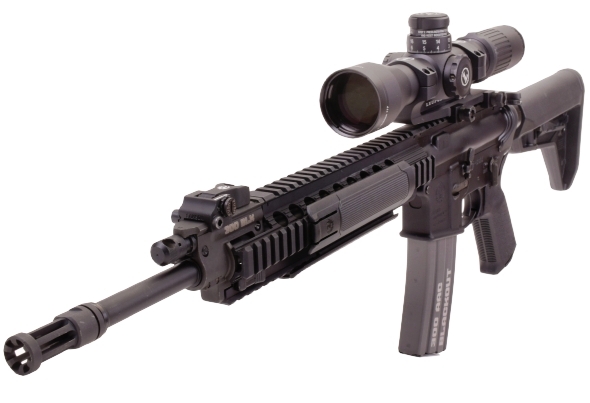
I’ve always thought the SR-556 was a pretty classy firearm but, until now, the solution for multiple cartridge capability was the same as any other AR. With the SR-556TD’s good quality, reliability of function and the ability to change cartridges with a quick barrel swap, I think I am ready to get one back into my collection. Nifty rifle with broad applications and some pretty exciting innovation.

Email Notification